Mission: Impact podcast & blog
Build a better world without becoming a martyr to your nonprofit cause
Listen on:
|
As a nonprofit leader and now nonprofit consultant, I consider myself a life-long learner. In fact ‘learner’ is one of my top five strengths in both the Gallup StrengthsFinder assessment as well as Via values assessment. I spent some time in December looking back at the year and one of the things that I thought about my year in terms of learning. Learning shows up in a couple different ways for me. I love to read and have shared short summaries of a few of the books I have read this year in these posts – summer book reviews – winter book reviews. I also ask myself the question, “what did I learn?” each week when I do my weekly reflection. Thus I capture the informal learning that emerges as I work. Designing learning experiences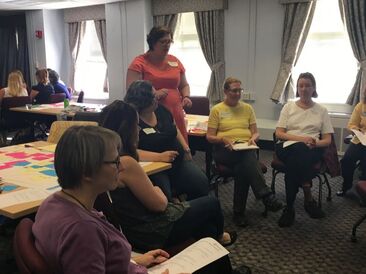 I design learning experiences for others as well. This year that included speaking engagements including workshops and sessions on a variety of topics:
I also created more in depth learning experiences for others. I led day-long workshops on building partnership and board development for a network of nonprofits as part of a longer series of trainings on strengthening organizational sustainability. One of the highlights of the past year was partnering with a colleague and 14 (relatively) new executive directors to facilitate a program designed to meet their specific needs. Through content and peer coaching, the group evolved over the course of eight months from a collection of individuals to a group who trusted each other with their most pressing challenges. It was so rewarding to support and help cultivate that shift. Nonprofit evaluative practice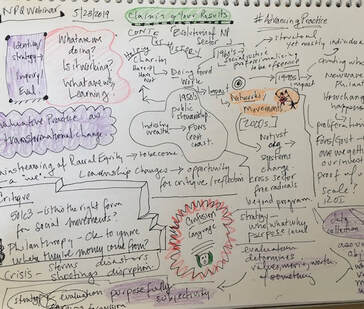 Claiming Your Results Claiming Your Results I participated in formal learning experiences offered by others. When I do, I practice my novice sketch-noting skills. A few highlights included: Nonprofit Quarterly’s webinar series on evaluative practice led by Jara Dean-Coffey and Jeanne Bell. The series stretched my conception of program evaluation and building learning organizations. My biggest take-away was the caution to be mindful of the purpose of any research. Part of this means making explicit the recognition that evaluation is always inherently subjective, even though it is often perceived as objective and the arbiter of worth and value. Being mindful of equity in evaluationToo many evaluation and other research efforts for programs that serve marginalized communities have been designed with the organization or researcher’s needs in mind, leaving the impact on the community out of the picture. The impact of this approach may be unintended or unintentional yet is extractive nonetheless. Learning and evaluation needs to be in service of the mission and mindful of impact, not just because one is curious. Learning with the brain in mind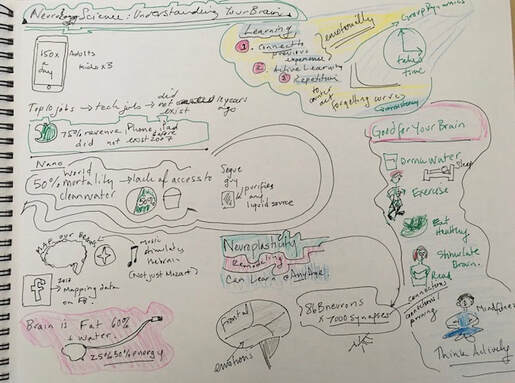 A session at American Society for Association Executive's (ASAE) Annual Conference in August focused on the basics of neuroscience and learning. Scientists now know that as adults we have neuroplasticity. So old dogs can learn new tricks! Designing learning with the brain in mind includes connecting the new information/content emotionally to the person’s previous experience, working with the material actively and repetition. It was good to hear that keeping my brain healthy includes all the habits we all have heard are healthy generally – staying hydrated, getting enough sleep, moving regularly, eating healthy, cultivating mindfulness and stimulating our brain on a regular basis. The last few years I have managed to make all of those regular practices, especially by reminding myself – something is better than nothing. Mission focused Collaboration Networks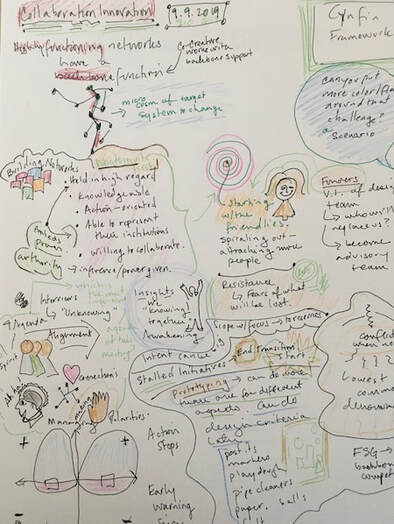 An exciting intensive training that I participated in focused on Collaborative Innovation. It centered on how to build collaborative networks intentionally to bring together organizations and groups of people. Networks have the potential to solve wicked problems beyond the capacity of one organization. Yet collaboration can be challenging and time intensive. By incorporating aspects of human centered design with iteration, rapid prototyping and testing, the network can move to action and not get bogged down in analysis paralysis. When started with intention they include both the power brokers in a system and those impacted by the system at the grassroots level, starting with the friendlies and then spiraling out. Harvesting in facilitation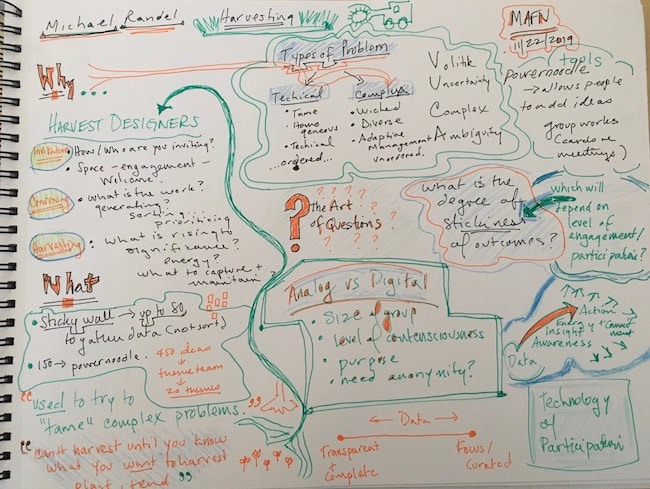 An important skill in facilitating is harvesting -- designing a meeting, a convening, a retreat with a set of intentions and outcomes in mind that will be harvested from the conversation. The degree of stickiness of the outcomes from a process is dependent on the level of engagement of those participating. When people talk about buy in, they need to remember that buy in is built not bought. Just telling people about a vision or a direction is not enough. Dewey contended that there is no real learning without reflection. “We do not learn from experience... we learn from reflecting on experience.” What are you reflecting on as the new year launches?
 Photo by Markus Spiske temporausch.com from Pexels Photo by Markus Spiske temporausch.com from Pexels I recently worked with a team at a local nonprofit organization to help them get a better sense of each team member’s strengths. They wanted to think about how they could better integrate those strengths into their work every day. Rather than focusing on trying to fix your weaknesses, building on what already comes naturally can help you move into a state of flow more frequently and do better work. In his book Drive, Daniel Pink describes what researchers have learned about motivation. External motivators – incentivizing behavior with rewards—can work in the short run. Yet for knowledge work, extrinsic rewards are actually demotivating over time. Instead mastery, autonomy and purpose are the keys to tapping into people’s own motivation. Learning more about your team’s strengths and giving them more opportunity to use those strengths gives them more chances to feel mastery and flow. This creates a virtuous circle of motivation! Getting startedA good place to start is to invest in the Gallup Strengthsfinder assessment. It is as easy as buying the CliftonStrengths 2.0 book or Strengths Leadership. With the book, you receive a code that enables you to take the assessment and learn about your top five strengths (out of 34). You receive reports that explain how these show up in your work and life. Both books are in the 10-$15 range so are pretty affordable. If you are looking at this for yourself, you might consider tracking which of your strengths you are using regularly in your work over a week or a month and then see what is missing. If you are not using a strength as often, how can you build it in? Gallup organizes their 34 strength themes into four categories or domains. These include executing, influencing, relationship building, and strategic thinking. Executing is all about getting things done. Influencing is about having a wider impact on a broader audience. Relationship building is pretty self-explanatory – it is all about emotional intelligence and the people side of things. Strategic thinking is about learning and scanning with a futuristic perspective – imagining what could be and helping the team make more informed decisions. Putting strengths to workI have had teams each take the assessment and then we had conversations about how we might capitalize on the strengths that the team brings to the table. Some questions that we considered included: • What are your strengths and why are they important to you? • How are you using your strengths in your work? • How could you better integrate your strengths into your work? • Are there projects coming up that your strengths might make you uniquely suited to contribute to? Team level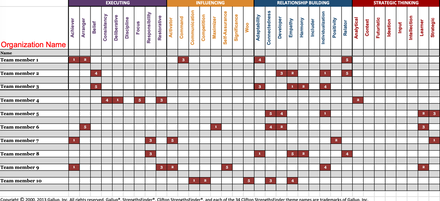 We then stepped up a level and looked at our strengths as a totality. We plotted everyone’s strengths against the four domains to see our strengths as a composite. A sample of what this could look like is to the left. We then discussed: • Where is the team strong? How does that show up in our work? How you work together? • How can we capitalize on the team’s collective strengths? • Are there gaps that might mean the team has blind spots? What does this mean for our work? Integrating strengths into your workHow will the group stay aware of each other’s strengths? Just having one conversation about strengths will not serve to keep these front and center as you do your work and plan for the future. Some possibilities include:
• Starting staff meetings periodically with a question about how team members have used a strength in their work recently. • How can you incorporate considering each team member’s strengths as you plan for who will be part of future projects? • If they can’t add a project to their workload, could they advise on the project? • How can you build it into your processes and how might you shape each team member’s assignments to better capitalize on their strengths? Want help identifying and tapping into the strengths of your team? Inquire about a coaching session. |
Archives
April 2024

Grace Social Sector Consulting, LLC, owns the copyright in and to all content in and transcripts of the Mission: Impact podcast, as well as the Mission: Impact blog with all rights reserved, including right of publicity.
|
Telephone301-857-9335
|
info[at]gracesocialsector.com
|
Grace Social Sector Consulting, LLC, owns the copyright in and to all content in, including transcripts and audio of the Mission: Impact podcast and all content on this website, with all rights reserved, including right of publicity.
|